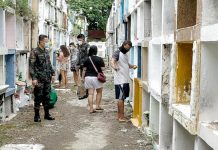
ILOILO – A series of tremors that shook Panay Island in recent weeks has prompted renewed calls for the establishment of a permanent earthquake monitoring station in Iloilo, as local disaster officials warn of the looming threat from the West Panay Fault, which could potentially unleash the region’s version of the “Big One.”
Retired Police Colonel Cornelio Salinas, head of the Provincial Disaster Risk Reduction and Management Office (PDRRMO), said the recent quake near Guimbal should serve as a wake-up call for the Department of Science and Technology (DOST) and the Philippine Institute of Volcanology and Seismology (PHIVOLCS) to act with urgency.
Panay Island is highly vulnerable to intense seismic activity due to the West Panay Fault, a significant geological fault line. It stretches over 90 kilometers, traversing towns in Iloilo (San Joaquin, Miag-ao, Igbaras, Tubungan, Leon, Alimodian, Janiuay, Lambunao), Antique (Sibalom, San Remigio, Valderrama, Pandan), Capiz (Tapaz, Jamindan), and Aklan (Libacao, Madalag, Malinao).
“It is high time they come up with the necessary instruments. The epicenter in Guimbal, Iloilo, is a total wake-up call for DOST — for them to decide fast and establish the appropriate monitoring station,” Salinas stressed.
He suggested modeling the facility after the Philippine Atmospheric Geophysical and Astronomical Services Administration’s (PAGASA) regional weather forecasting centers, equipped with real-time data systems and trained personnel for seismic monitoring.
He also raised the possibility of transferring PHIVOLCS’ Roxas City-based operations to Iloilo City, which hosts the regional government offices.
“Policymakers should study whether PHIVOLCS needs to set up a permanent regional office here in Iloilo. This is where the regional centers for Region VI are located, so it only makes sense,” Salinas said.
Lesson from the Past
The most potent earthquake ever recorded on Panay Island occurred on January 25, 1948 — a magnitude 7.8 tremor dubbed the “Lady Caycay” earthquake.
Centered near Anini-y, Antique, its Mercalli intensity reached X (“Extreme”), ripping open fissures across Iloilo and Antique, and causing a small tsunami that reportedly killed two along the Iloilo Strait.
The destruction was widespread, and more evident on Spanish-era churches — 55 were hit and 17 collapsed outright. In Iloilo alone, belfries of historic churches in Jaro, San Joaquin, Arevalo and others toppled.
Reports at that time told of approximately 21 fatalities and 43 injuries.
Infrastructure failures included ground fissures up to four meters wide, and collapsing bridges and buildings.
The “Lady Caycay” earthquake remains the second-strongest in Philippine history, surpassed only by the 7.8 magnitude event near Luzon in 1990.
Preparedness and Drills Intensified
The PDRRMO has ramped up earthquake and landslide preparedness, conducting regular drills and enhancing monitoring instruments across vulnerable municipalities. Sensors have detected minor ground movements during heavy rains, though no evacuations have been deemed necessary so far.
Salinas said local rescue teams are also undergoing advanced training to handle structural collapses and mass-casualty scenarios, while public buildings are being inspected for cracks and vulnerabilities.
He assured the public that the Iloilo Provincial Capitol remains structurally sound and capable of withstanding strong tremors.
“This building can hold up to an intensity 8 earthquake. Our engineers regularly check its beams and columns, and we document every crack for evaluation,” he explained.
Coastal Towns Urged to Prepare for Tsunamis
While most of Iloilo is landlocked, Salinas warned that coastal barangays — from San Joaquin town in the south to Carles in the north — should prepare for possible tsunami impacts, especially if a major quake strikes the Negros Trench.
“Our coastal areas should be prepared. It will happen — and if it does, what should we do? We must know our coping mechanisms,” he said, noting that the office continues to assess data from national agencies to refine projections.
‘Readiness Is Not Optional’
The provincial government is urging stronger coordination among local governments, PHIVOLCS, and the DOST to fast-track the installation of monitoring stations and public education programs on earthquake safety.
“The most important thing is to have earthquake-resilient infrastructure and a community ready to act when the Big One comes,” Salinas emphasized.
As seismic activity grows more frequent, Iloilo’s disaster officials stress that readiness is no longer optional — it is a survival imperative for Western Visayas./PN




